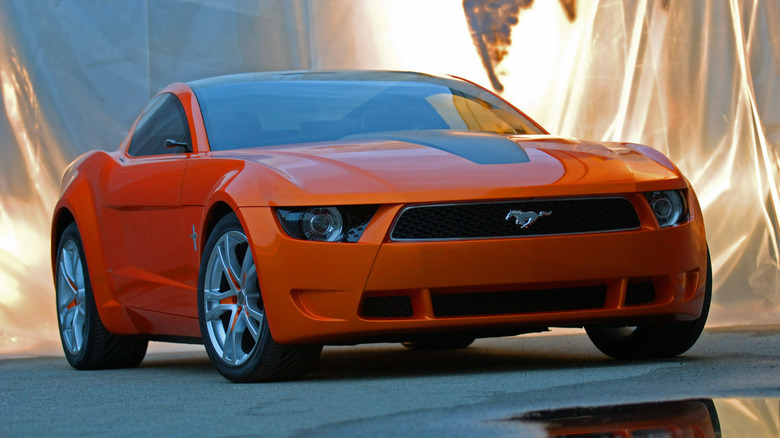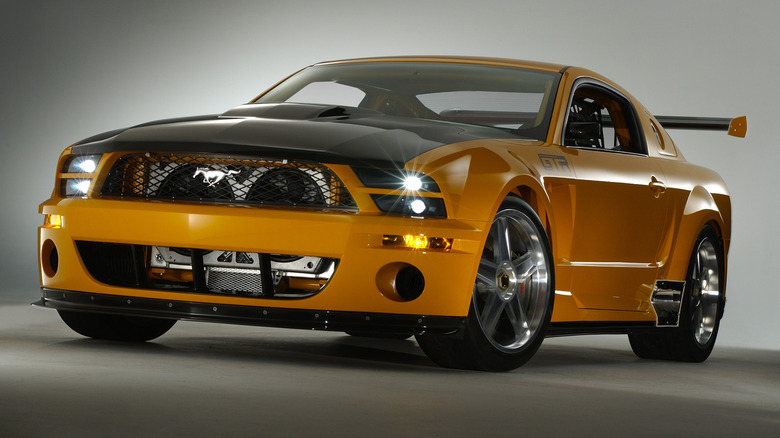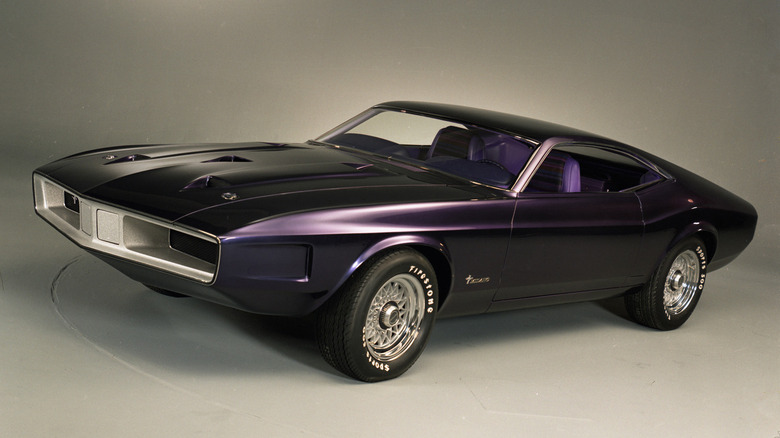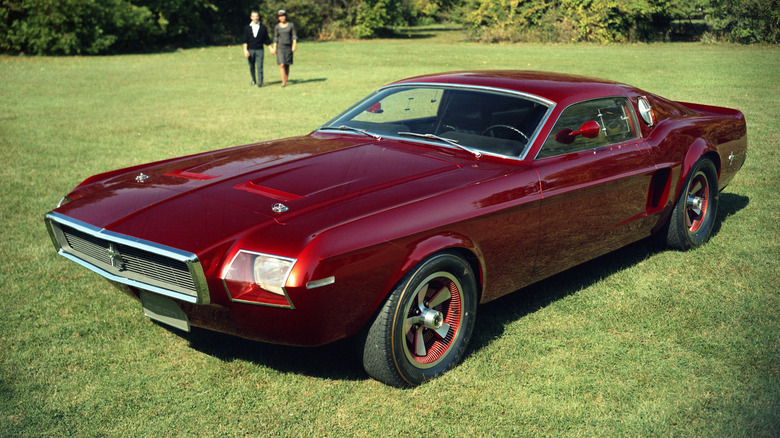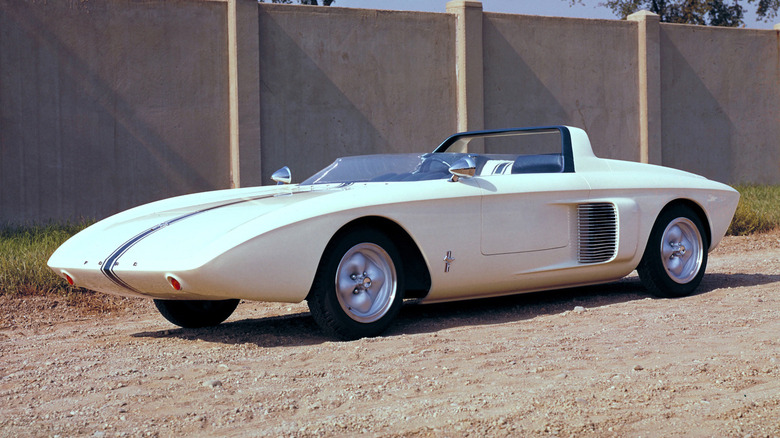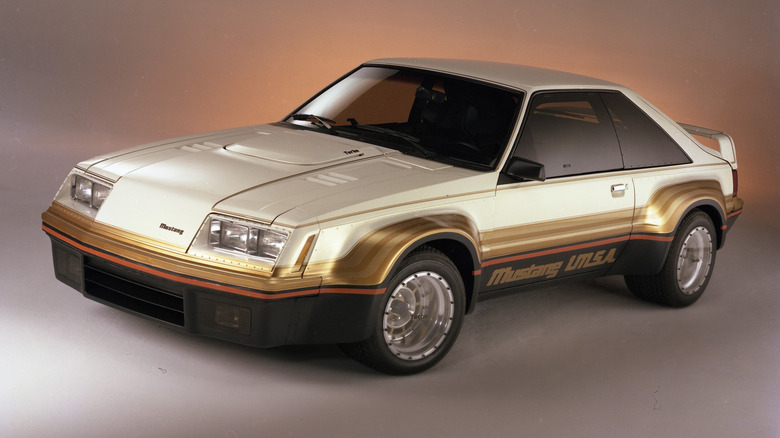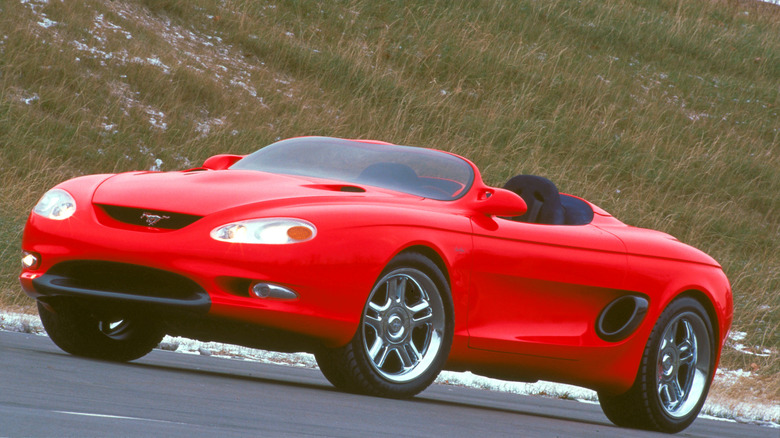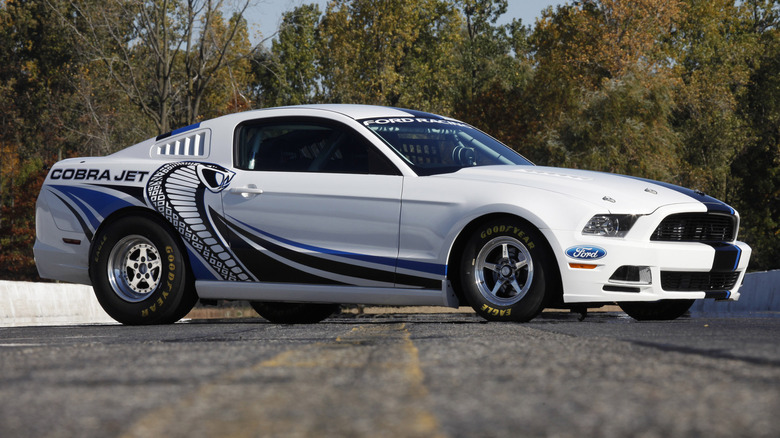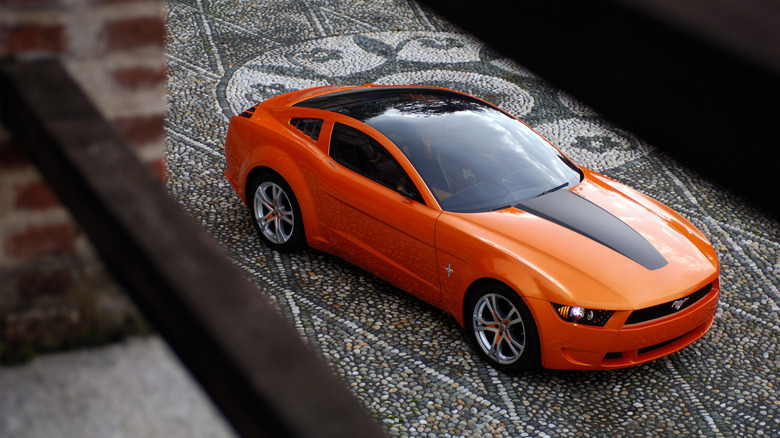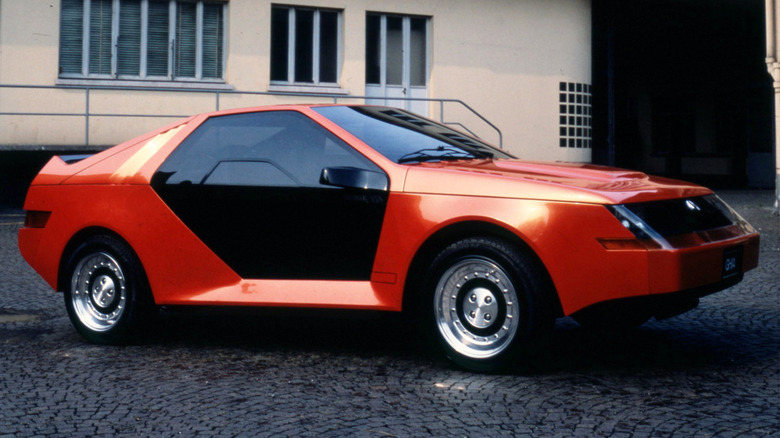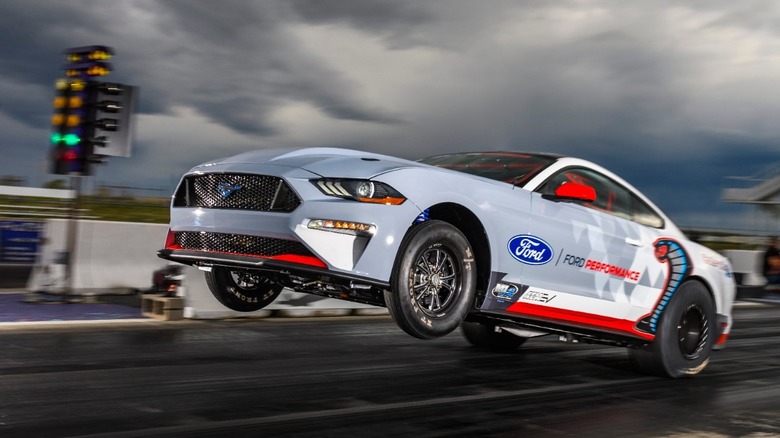10 Of The Coolest Ford Mustang Concepts Ever Revealed
Concept cars are a vital way for manufacturers to test out new ideas, technology, and designs, giving them the opportunity to gauge the public's reaction before committing to a production run. They also serve as a way to give designers creative freedom, pushing the boundaries of what can be achieved from an existing platform.
They are particularly important to the history of the Ford Mustang, with the model's significant changes over its six decades on sale being shaped by the public and press reactions to various Mustang concepts. It's safe to say that, without the long line of Mustang concepts dreamed up by Ford designers and their collaborators, the Mustang would not have been the globally renowned success story that it is today.
From the everyday base models to the ultra-rare collectors' grails, every Mustang on the road has been shaped to some degree by a previous concept car, and these are among the coolest that the brand has unveiled to date.
Ford Mustang GT-R
Unveiled in 2004, the Mustang GT-R concept was built to commemorate both the 40th anniversary of the Mustang nameplate and the launch of the fifth-generation Mustang. It was no simple design study, instead being a fully functional one-off race car that underwent significant testing on the track before hitting the auto show circuit. The Blue Oval used it as a testbed for performance parts, some of which were to be adopted into Mustang racing programs, and others were to be made available to customers under the Ford Performance brand.
While it was thoroughly upgraded underneath, the concept's designers wanted to keep the GT-R's body shell as stock as possible. Around 85% of the stock body panels were reportedly carried over. Of course, the roll cage, side exit exhausts, and large rear wing were new additions, but none were solely for show purposes. They were designed to be as close to competition-ready as possible and comply with the regulations of major racing series, giving Ford maximum options when it came to future motorsport programs for the Mustang.
Ford Mustang Milano Concept
A concept's design can often prove influential to later production models even if the concept itself doesn't end up directly resembling any of them. One particularly notable example is the 1968 Alfa Romeo Carabo — the Bertone-styled concept never made production, but its wedge shape inspired a generation of performance cars including the Lamborghini Countach. The 1970 Mustang Milano Concept can't claim to be as influential as the Carabo, but it did end up inspiring future Mustang generations and the Australian-market Ford Falcon.
The Milano took design inspiration from European sports cars, particularly Italian models, with a lower, sleeker profile and a roofline that sloped down to integrate seamlessly with the large rear hatch. The car also featured an early example of faux-wire wheels, which later made their way onto production vehicles. The Milano itself remained only a design study, being one of many churned out by Ford to gauge public reaction to potential Mustang design changes. However, it ended up being more influential to future production coupes than many other concepts of its era, despite never making it into production.
Ford Mustang Mach I Concept
The Mach I name has a longer history at Ford than many enthusiasts might expect. It was first used in 1959 for a pod-like vehicle that featured air cushions instead of conventional wheels, and it wouldn't be used on a performance Mustang concept until 1966. That initial concept went through several design phases, being shown at the Detroit Auto Show in 1967 and then refreshed with a new nose and other styling tweaks for 1968.
The 1968 model — pictured above — ended up looking quite different to the production Mustang Mach 1 that would appear for 1969, with the nose in particular being overhauled. That nose was around seven inches longer than the stock Mustang, and featured a unique grille. The headlights were also unique, being rectangular rather than round and fitted with lens covers that ran level with the car's bodywork for better aerodynamics. None of those design features made it into the production car, but given the Mach I Concept's ungainly snout, that was probably a good thing.
Ford Mustang I Concept
Ford tried several wildly different designs before settling on the one that would become the original production Mustang. An early iteration was the Mustang I Concept, a bare-bones roadster that Car and Driver tested at Ford's Proving Grounds in 1963. The outlet noted that the car was, on the whole, enjoyable to drive, but suffered from several practicality and space limitations that made it uncomfortable over longer periods.
The concept featured a 1.5L four-cylinder engine making 90 horsepower, with a redline of 7,500 rpm. It was mated to a four-speed manual transmission, and sported rack-and-pinion steering that Car and Driver's testers were particularly impressed by. In terms of styling, the car was unlike any production car Ford had built before, and as it would turn out, unlike any it would build in the future. The eventual production Mustang was a much more practical, widely appealing design, and a world away from the track-ready vision proposed by the designers of the Mustang I Concept.
Ford Mustang IMSA Concept
The '70s were not kind to American performance cars. Those produced at the end of the decade were on the whole significantly less powerful than those produced at the start, thanks to a combination of new regulations, the Oil Crisis, and changing market tastes. Ford still wanted its Mustang line to be associated with track-ready performance even though its road cars were slower than before, and that's where the Mustang IMSA Concept came in.
It borrowed its name from the International Motor Sports Association, the organization in charge of regulating American racing series. This was little more than a marketing ploy — the concept wasn't built to the standards of any particular series, nor did Ford intended to use the car in competition in the future. The stock Mustang's 2.3L engine and four-speed transmission were carried over, with the main changes to the car being the interior and exterior overhaul.
The car's interior was given a full race-inspired makeover, complete with Recaro bucket seats and four-point harnesses. The body shell was also tweaked for better aerodynamics, while wider fenders hid competition-ready Pirelli tires. Despite being only a show car, the Mustang IMSA Concept was Ford's way of reminding everyone that it still cared about performance models, even if it could no longer release high-powered road-going specials like it had a decade earlier.
Ford Mustang Mach III Concept
According to a Ford press release from its launch, the Mustang Mach III Concept was designed to "blend the styling cues of the classic Mustang with Ford's state-of-the-art design and technology." Its low windshield, flowing bodywork, and two seater layout echoed a similar formula to early Mustang concepts like the Mustang I Concept, except the Mach III Concept was faster. Much faster, in fact: Ford claimed a 0-60 mph time of under 4.5 seconds thanks to the 450 horsepower V8 engine under its hood.
Carbon fiber was used to create the car's body panels in a bid to keep weight to a minimum, and the bumpers were integrated into the bodywork for a more flowing silhouette. The car's engine was cutting-edge too, using a flex-fuel system which could accept a varying mix of methanol and gasoline thanks to a continuous monitoring system. While the roadster Mustang never made it to production, both the front and rear fascias of the car bear a resemblance to the later SN95 Mustang.
Ford Mustang Cobra Jet Twin-Turbo Concept
The Mustang Cobra Jet had already been tearing up drag strips for several years by the time Cobra Jet Twin-Turbo Concept was unveiled in 2012. It was built for SEMA and showcased Ford's newly developed turbocharged drag powertrain — a naturally aspirated and a supercharged option were already available to order, but not a turbocharged one. The Cobra Jet program returned in 2008 after originally winning over fans a full four decades before, and Ford had offered a small number of turnkey drag racers every year since.
The Twin-Turbo Concept represented a potential addition to its catalog, although at the time of its unveiling, Ford had neither confirmed nor denied whether it would be put into production. Despite claiming that the concept was superior to its previous efforts, Ford didn't disclose horsepower figures, torque, or quarter mile times. Instead, its press release simply called its torque "tire-frying." Ford has continued to evolve and improve its Cobra Jet racers in the years since, recently turning heads — and polarizing opinions — with its electric Mustang Super Cobra Jet 1800.
Ford Mustang Giugiaro Concept
Industry legend Giorgetto Giugiaro has been responsible for the designs of many iconic cars, including the BMW M1, DeLorean DMC-12, and VW Golf. However, he didn't design the Mustang Giugiaro Concept – instead, it was his son Fabrizio Giugiaro who was responsible for the car's creation. The younger Giugiaro reportedly came up with the idea through a conversation with a Ford executive, with the designer telling Evo that the fully functional concept took around 35,000 man hours to build.
The car's unique bodywork and striking orange paint are complemented by an equally head-turning soundtrack thanks to the car's supercharged V8 engine that produces around 500 horsepower. The inside is unique too, being given a makeover with high-end materials including Skewbald pony leather. A single piece glass canopy forms the windshield and roof, and is made from a unique kind of crystal designed to absorb harmful UVA rays from sunlight. The concept was always intended to be a one-off, and so no production version was considered.
Ford Mustang RSX Concept
Ghia gave the Mustang a rally-inspired makeover in 1979, the same year that the Mustang IMSA Concept was also unveiled. Much like the IMSA Concept, Ghia's Mustang RSX Concept wasn't upgraded under the hood — in fact, it featured a base-spec four-cylinder engine making just 89 horsepower. Instead, Ghia relied on the car's boxy styling to make a statement.
The RSX was shorter and wider than a regular Mustang, with a large rear wing and unique wheels giving it a sportier, more aggressive look than its production counterpart. The cabin was also revamped, with revised seats and a suede dash. The car wasn't intended to be a production design, but much like its racing-inspired IMSA stablemate, it was primarily a way to drum up interest in the Mustang and the Ford brand at large. That it certainly did, although it's a shame that Ghia didn't at least try to upgrade its measly horsepower output to reflect its sportier styling.
Ford Mustang Cobra Jet 1400
The idea of an electric Mustang will always be contentious, even if enthusiasts have mostly come to terms with the existence of the Mustang Mach-E. However, if all electric Mustangs boasted the performance chops of the Mustang Cobra Jet 1400, it's safe to say that far fewer would object to the idea. According to Ford, the Cobra Jet 1400 boasts 1,502 wheel horsepower and can run a quarter mile in 8.27 seconds.
It was designed to be part show car and part technological testbed, being both a platform for Ford's performance engineers to hone the capabilities of the brand's electric drivetrain and demonstrate to racing fans the inherent acceleration advantages of battery technology. It's since been succeeded by the Mustang Super Cobra Jet 1800, which is even more powerful, with over 1,800 horsepower on tap. It remains to be seen how integrated electric vehicles become in drag racing, but one thing's for sure — their performance certainly isn't a limiting factor.
